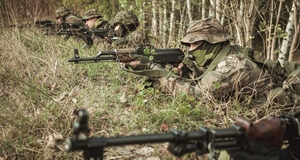Sled Dogs: Cultural Legacy and Forgotten History
By
2010, Vol. 2 No. 09 | pg. 1/1
KEYWORDS:
Sled dogs have been acclaimed for their heroism, athleticism, and their unconditional affection through numerous books, movies, and other media outlets. This legacy has aided the formation of a romanticized perspective on dog sledding. Sled dogs have prompted issues of concern and curiosity targeting an array of groups ranging from animal activists to the U.S Military. Cultural legacy has dominated the popular perspective on sled dogs, illustrating an Alaskan subculture. In contrast, Charles L. Dean explored the latent significance of these canines in his book Soldiers and Sled Dogs. In his publication Dean uncovers the use of sled dogs during World War II. There is a common misfortune in the research regarding dog sledding. The actual use of dog sleds as transportation vehicles is commonly ignored due to the legends and stories surrounding the sport. Common associations with dog sledding are the Iditarod, Susan Butcher, Siberian Huskies, snow parkers, fur, toboggans, Balto, and “Mush!” All of these fall under the common denominator of an Alaskan subculture, based on man and dog’s struggle against the wild. One example of this struggle is represented by a statue in Central Park with a statue of a dog named Balto symbolizing the bravery of a dog sled team that transported diphtheria antitoxin serum to an isolated town of Nome in 1925, accessible only by dog sled.[2] Some claim the Iditarod; a.k.a “The last great race on earth” is a commemorative race in tribute to the dog team’s survival and heroism.[3] Others claim the race was a tribute to the Gold Rush era of 1898 to 1906.[4] Dog sleds were the common mode of transportation. The Iditarod Trail was the conduit for these sleds transferring mail, provisions, and of course, gold.[5] The official Iditarod website acknowledges both accounts as commemorative factors in the notorious race.[6] The race is infamous for it’s hazards in regards to weather and climate conditions, trail conditions, and length. The race itself is over 1,150 miles and is completed within 10 to 17 days.[7] The starting point is Anchorage and the finish line is Nome.[8] The Iditarod defines this subculture and is more famous than any other dog sled racing event in the U.S.Legends have emerged into Alaskan history due to the Iditarod. The most famous is Susan Butcher, who won the Iditarod race four times.[9] This accomplishment did not come without turbulence. One particular race before her triumphs, a moose killed one of her dogs and injured a significant portion of the pack, thus forcing her to withdraw from the 1985 race.[10] She survived, and was praised for her ability to relate to her dogs as well as her compassion.[11] Susan describes the relationship with her dogs, “They’re everything-my friends, family, and co-workers.”[12] She was the second woman to win the Iditarod and set the most records out of any female.[13] A Saturday in March before the start of the Iditarod, there is a day in Susan’s honor to remember her legacy, which was instated after her death from Leukemia.[14] She is the epitome of an American legend, facing the dangers of the wild and ascending to victory in the face of failure. This American subculture does not come without criticism. Susan was not the only one to lose a dog’s life during the course of this treacherous race. Animal activists have brought into question the safety and treatment of the dogs involved in racing. In 2009 activists claim there were a minimum of 146 dog fatalities since 1973.[15] The spokesman for the Iditarod claims there is no exact number, but weather conditions can make the numbers spike depending on the year.[16] Like many sports, this one has evolved over the years, incorporating numerous rules for protection of the dogs. In the 2009 Iditarod Race Rules Manuel there are numerous instances where the dog’s best interest are supported by written rule. Under “Rule 2” it clearly states, “No one convicted of a charge of animal abuse or neglect, as such is defined under Alaskan law, may enter the Iditarod Trail Sled dog Race.” [17] There are lists of mandatory breaks a musher must take, giving specific time intervals. [18] The toboggan itself must be structured to carry any “injured or fatigued” dogs.[19] “Booties” are required for dog’s feet, along with back ups at all times.[20] A Veterinarian notebook must be kept in detail, and presented at check-ins with Veterinarians at designated checkpoints.[21] The rules even go as far as to disqualify or withdraw any aggressive dogs at any time.[22] The same goes for the Mushers, “A Musher whose conduct, constitutes an unreasonable risk of harm to him/her, dogs or other persons may be withdrawn.”[23] Under “Rule 37” there are distinct guidelines to dog care including, “There will be no cruel or inhumane treatment of dogs. Cruel or inhumane treatment involves any action or inaction, which causes preventable pain or suffering to a dog.” Although dog fatalities are a possibility it is clear in the Manuel they will be treated with precedence and investigated. The dog breeds used for this type of activity have been bred and trained for this type of activity. The Siberian Husky which is a common breed used in the Iditarod is depicted in the American Kennel Club as “…known for its amazing endurance and willingness to work…suitable for anything from sledding to therapy work....”[24] This particular breed also originated in cold climates, thus giving it the dense coat necessary for keeping warm even in the coldest conditions.[25] As said by the late Susan Butcher, “They are athletes and are trained and chosen for competition just like any athlete.”[26] The excitement and controversy surrounding the race veils the sled dog’s literal use, transportation. As much as these stories and athletes have contributed to this Alaskan subculture, many already know the essence of these stories and their legacy. This is in part due to the readily available research regarding this subculture and what the media outlets produce. What the public is not as exposed to is the operational use of sled dogs in World War II. Charles L. Dean is one of the few authors to produce an in-depth assessment on the operational use of sled dogs. Until Dean’s research, it is only through passing plot lines that one hears of dogs transporting mail, provisions, or medicine. Dean goes into great detail of these military dogs’ job descriptions and their origins. Dean discovered a military document from the War Department entitled Basic Field Manual, Dog Team Transportation. This discovery was the inspiration for Dean’s research on the utilization of dogs during World War II. Dean is an “Arctic Expert,” who through a variety of sources and research composed an insightful look into the world of Army sled dog teams. Dean acknowledges in the Preface of his publication, “…there was very little material on the subject, and what there was did not go into detail.”[27] Again this exhibits the pre-conceived notions about what non-racing dogs accomplished due to lack of research. Therefore this small stint in U.S history tends to get lost. The origins of these working dogs again target the Gold Rush era. Dean exclaims that dogs have been helping man for thousands of years.[28] What these dogs accomplished during World War II was more heroic than any race. Surprisingly, the birth of the U.S military dog sledding did not originate in Alaska but New Hampshire.[29] Dean further illuminates New England’s culture for dog sledding as to show that Alaska isn’t the only state with a dog sledding culture, again uncommon knowledge. Throughout the book these dogs completed numerous essential tasks. From transporting munitions and supplies to lying almost twenty feet of telephone wire in one night for soldier communication.[30] Their primary task was search and rescue, dog teams were sent to find lost pilots whose planes had gone down.[31] The U.S military originally chose these dogs for one vital reason. “ Dogs were eminently more economical than horses. Two seven dog teams could do the work of five horses in the formidable terrain.”[32] These dogs could endure conditions that no other domestic animal could. Where all other modes of transportation failed, the sled dogs delivered. The prototype for the original Army dog sleds were eight dogs per teams with one spare along with around an 8 foot by 31-inch toboggan. The harness was about 1 inch wide composed of military cotton and padded with felt made of wool.[33] There was no set structure for these sleds it varied by individual owner, yet this was the original structure used. Ski patrol soldiers mainly accompanied these dog teams. The training for these soldiers moved out to Montana, for it’s arctic like terrain, for the majority of World War II[34]. A common problem in training was the lack of discipline of the soldiers in training, due to the treating of dogs as pets. [35] Minus this glitch, over two hundred sled dog teams were intact, and many were sent to Canada and the Arctic for search and rescue missions.[36] The camp was open from around 1942-1944, which was considered the most prominent time in the dog sled training years for the U.S Army. [37] The mission of sled dog teams ended at the conclusion of the war, ironically around the same time the air force became it’s own branch of military.[38] The statistics speak for the lost legacy of these dogs; “ Men and dogs search and rescue squadrons effectively retrieved approximately 150 survivors, 300 causalities, and millions of dollars worth of equipment by the close of world War II.” [39] The one thing that is consistent whether through racing or military dogs is the bond between the dogs and their mushers. Although the racing dogs hold no less courage or athleticism than the military dogs of World War II, these military dogs are often lost within their short time in history and do not receive the recognition they deserve. The Iditarod dogs helped to form a subculture; despite criticism from activists the Iditarod’s following is still strong. These dogs with their furry faces and grinning smiles lead us to look past the vehicle aspect of dog sledding and marvel at the dog’s capabilities and the legends they created. However it must not be forgotten that this is a vehicle of American history that saved lives during one of the worst wars this world has known. In the words of Charles L. Dean: Although it may seem that dog sleds are an obsolete mode of transportation in this age of space travel…sled dogs are still far superior to aircraft and track vehicles, a dog requires no repair shops or spare parts…The sled dog is so essential…it represents the accomplishment of travel…In one of the most desolate an inhospitable regions on earth, the dog is still man’s best friend.[40] References Dean, Charles L. Soldier’s and Sled Dogs. London: University of Nebraska Press, 2005. Riddles, Libby. Race Across Alaska: The First Woman to Win the Iditarod Tells her Story. Pennsylvania: Stackpole Books, 1988. Chamberlain, Tony. “Mushing is What Butcher Likes Doing Best.” Boston Globe, March16, 1990. http://pqasb.pqarchiver.com/boston/access/61601266.html?FMT =ABS &date=Mar%2016,%201990 [accessed April 19, 2010]. D’Oro, Rachel. “Iditarod Raises Cries of Animal Cruelty.” Boston Globe, March 22,2009.http://www.boston.com/sports/outdoors/articles/2009/03/22/ iditarod_raises_criesof_animal_cruelty/ [accessed April 19, 2010]. “Four-time Iditarod Champion Dies at 51.” Boston Globe, August 6, 2006. http://www.boston.com/sports/other_sports/articles/2006/08/06/ four _time iditarod_champion_dies_at_51/ [accessed April 19, 2010]. Iditarod Staff. 2009 Official Rules: Iditarod Trail International Sled Dog Race. American Kennel Club. “Meet the Breeds: Siberian Husky.” The American Kennel Club. http://www.akc.org/breeds/siberian_husky/index.cfm [accessed April 19, 2010]. Cleveland Museum of Natural History. “Balto and theLegacy of the Serum Run: Fromthe 1925 ‘Serum Run’ to the Iditarod of Today.” Cleveland Museum of Natural History. http://cmnh.org/site/AtTheMuseum/OnExhibit/ PermanentExhibits /Balto.aspx[accessed April 19, 2010]. Iditarod Trail Committee, Inc. “Learn About the Iditarod.” The Official Site of theIditarod. http://www.iditarod.com/learn/ [accessed April 19, 2010]. Alaska’s Great Race: The Susan Butcher Story. DVD. Directed by Pal Laszio. PalProductions, Inc. 1985. [1] Charles L. Dean, Soldier’s and Sled Dogs (London: University of Nebraska Press, 2005), 107. [2] Cleveland Museum of Natural History, “Balto and theLegacy of the Serum Run: From the 1925 ‘Serum Run’ to the Iditarod of Today,” Cleveland Museum of Natural History, http://cmnh.org/site/AtTheMuseum/OnExhibit/PermanentExhibits/Balto.aspx [accessed April 19, 2010]. [3] Ibid. [4] Dean, 3. [5] Ibid. [6] Iditarod Trail Committee, Inc, “Learn About the Iditarod,” The Official Site of the Iditarod, http://www.iditarod.com/learn/ [accessed April 19, 2010]. [7] Ibid. [8] Ibid. [9] Alaska’s Great Race: The Susan Butcher Story, DVD, Directed by Pal Laszio, Pal Productions, Inc, 1985. [10] Libbey Riddles, Race Across Alaska: The First Woman to Win the Iditarod Tells her Story (Pennsylvania: Stackpole Books, 1988), 33. [11] Alaska’s Great Race: The Susan Butcher Story [12] Tony Chamberlain, “Mushing is What Butcher Likes Doing Best,” Boston Globe, March 16, 1990. http://pqasb.pqarchiver.com/boston/access/61601266. Html ?FMT =ABS&date =Mar%2016,%201990 [accessed April 19, 2010]. [13] Alaska’s Great Race: The Susan Butcher Story [14] Associated Press, “Four-time Iditarod Champion Dies at 51,” Boston Globe, August 6, 2006. http://www.boston.com/ sports/other_sports/ articles/2006 /08/ 06/ four _ time_iditarod_champion_dies_at_51/ [accessed April 19, 2010]. [15] Rachel D’Oro, “Iditarod Raises Cries of Animal Cruelty,” Boston Globe, March 22, 2009, http://www.boston.com/sports/outdoors/ articles /2009 /03/22 /iditarod _raises_ cries _ of animal_cruelty/ [accessed April 19, 2010]. [16] Ibid. [17] Iditarod Staff, 2009 Official Rules: Iditarod Trail International Sled Dog Race, 4. [18] Ibid, 6. [19] Ibid, 7. [20] Ibid. [21] Ibid. [22] Ibid. [23] Ibid, 9. [24] American Kennel Club, “Meet the Breeds: Siberian Husky,” The American Kennel Club, http://www.akc.org/breeds/siberian_husky/index.cfm [accessed April 19, 2010]. [25] Ibid. [26] Chamberlain, “Mushing is What Butcher Likes Doing Best.” [27] Dean, xiv. [28] Ibid, 1,3. [29] Ibid, 12. [30] Ibid, 5. [31] Ibid, 71. [32] Ibid, 5. [33] Ibid, 16. [34] Ibid, 23 [35] Ibid, 31. [36] Ibid, 67. [37] Ibid, 37. [38] Ibid ,42. [39] Ibid, 67. [40] Ibid, 105. Suggested Reading from Inquiries Journal
Inquiries Journal provides undergraduate and graduate students around the world a platform for the wide dissemination of academic work over a range of core disciplines. Representing the work of students from hundreds of institutions around the globe, Inquiries Journal's large database of academic articles is completely free. Learn more | Blog | Submit Latest in History |
















